The Brunton pocket transit is a particular interest of mine. Since my days as a geology student, taking strike and dip readings across the southwest US to my days as a topographer in the Army Corps of Engineers I’ve always found the pocket transit a marvel of ingenious, compact technology. I am rarely afield without one.
For more information on the Brunton pocket transit be sure to visit the Pocket Transit Resource Page. But first, a little background on this neat little instrument…
The pocket transit was developed and patented by David Brunton in 1894. Brunton, a noted mining engineer working in Colorado, recognized the need for a small, accurate, multi-purpose instrument suited for field exploration and mineral mapping. In his original patent application Brunton noted that the instrument can be easily carried in a vest pocket, hence the name ‘pocket transit’.
Brunton contracted with Denver-based instrument maker William Ainsworth & Sons to produce the first pocket transits. Ainsworth remained the primary manufacturer of Brunton pocket transits until after WWII. In 1972 the Ainsworth company folded and the Brunton company was formed to continue production. Original Brunton compasses are still manufactured today in Riverton, Wyoming.
What makes the pocket transit so useful is the integration of a number of different instruments into a single, easy to carry package. The Brunton pocket transit incorporates a highly accurate mirror compass, level and clinometer that reads in both degrees and percent of slope. The pocket transit also incorporates a sight vane that improves the accuracy of handheld readings and forms a longer sight baseline when the instrument is mounted on a tripod for more accuracy. This makes for an incredibly versatile instrument.
Here we see David Brunton himself demonstrating how to hold the compass at waist level for shooting an azimuth.
The pocket transit being used as a mirror compass
Here again we see David Brunton demonstrating how to use the clinometer feature in the pocket transit.
What added to the versatility of the pocket transit was the ability to clamp the instrument to a tripod to increase its stability.
Brunton even manufactured a clear acetate protractor allowing the pocket transit to be used as a plane table alidade.
Now let’s look more in-depth at the history of the pocket transit:
The Brunton pocket transit was patented in 1894 by David Brunton, a Colorado mining engineer. Brunton was frustrated by the number of survey instruments a mining engineer and geologist had to carry around with him (and I say ‘him’ because mining engineering and field geology was an exclusively male profession well into the 20th Century). In the late 1800s it was not unusual for engineers and geologists doing basic exploratory mineral mapping to lug around full sized survey transits, surveying compasses, tripods, clinometers, and plane tables. These instruments offered a high level of accuracy that simply wasn’t needed for exploratory surveys. As an engineer himself Brunton realized that what was needed a portable device that allowed field survey personnel to do fast and accurate exploratory quality surveys without being burdened down by equipment that was heavy, expensive and difficult to set up and use. These men were in the business of discovering, verifying and mapping mineral deposits that covered vast areas. Huge sums of money were at stake as mining and mineral companies scrambled to secure valuable leases on the stuff that was fueling America’s exploding industrial economy – timber, gold, silver, coal, iron ore, chromium, nickel, bauxite, petroleum and dozens of other minerals that were key to America’s growth. Field engineers and geologists needed to move fast, do rough mapping and get that information back to the office for the development of lease maps and boundary descriptions. They didn’t need to be burdened with heavy, sensitive and fragile survey gear if that level of accuracy wasn’t required. David Brunton recognized the problem and set to work developing a solution.
What Brunton came up with as a pocket-sized device that incorporated an accurate magnetic compass with a sighting vane, a clinometer, a level and a large mirror with a sight line. Housed in a machined aluminum case (still an expensive material in the late 1800s), it was rugged, reliable and useful.
Early Brunton pocket transit design
Brunton named his instrument the ‘pocket transit’, a lofty title for a fairly rudimentary mapping device. But the name served its intended purpose; in the mind of the engineer and geologist it set the device apart from the common handheld compass. Here was a professional instrument that offered a level of accuracy and functionality not found elsewhere.
Brunton had more than marketing on his side. The pocket transit actually delivered where it mattered – in the field and in the hands of engineers and geologists across North America. It delivered all the functionality and accuracy needed to get the job done. It ended up being the perfect device for the job at hand.
Demand for Brunton’s device increased steadily and improvements were introduced. An additional bubble level and a cover mounted peep sight were added in 1912. In the same year Brunton introduced modifications to the case that allowed mounting the instrument on a non-magnetic tripod or jacobs staff. (It’s interesting that in his 1894 patent application Brunton derided other compass designs that needed to be tripod mounted, but in the 1912 patent application he discusses tripod mounting like it’s the greatest idea since sliced bread.) Somewhere between 1894 and 1912 the pocket transit acquired the ability to pre-set magnetic declination by use of an adjustment screw on the side of the case. By 1926 Brunton’s design had fully matured with the addition of a bullseye level for improved leveling and the addition a percent grade scale to the clinometer. From this point forward it was minor improvements in materials, manufacturing techniques and the added availability of different compass ring layouts (degrees, quadrants, mils, etc.).
A pocket transit set out in quadrants
From the beginning David Brunton licensed the Colorado instrument maker William Ainsworth & Sons to produce the pocket transit. After Brunton’s death in 1927 Ainsworth purchased the manufacturing rights to Brunton’s designs and continued manufacturing and improving the pocket transit through the late 1960s. In 1972 the production rights and the Brunton name were purchased by the Brunton Company of Riverton, Wyoming. The Brunton Company continues to manufacture this basic design.
Military version of the pocket transit (known as the M2) set out in mils (a mil is 1/64000’s of a circle)
The Brunton design was so well thought out that engineers and geologists quickly developed field techniques keyed to the pocket transit’s unique layout and construction. The best example is the determination of the strike and dip of rock formations. Most sedimentary and metamorphic rock formations are not horizontal. They were all deposited in horizontal layers but over geological time (i.e., millions of years) those horizontal layers have been warped and deformed by pressure and other geological forces. One of the keys to understanding these forces is mapping the strike (the horizontal angle of deformity) and dip (the vertical angle of deformity) of individual rock layers. Before the Brunton pocket transit the measurement of strike and dip was a clumsy process involving two separate devices – a field compass (often a fairly large and somewhat fragile device) and a clinometer. With the Brunton the process is quick and simple – open the instrument and lay it horizontally against the rock formation. Keeping the edge of the instrument in contact with the rock face rotate it up and down slightly until the circular level is centered. Note the magnetic azimuth as indicated by the compass needle. That is your strike. Score a line on the rock face horizontal to the pocket transit using a piece of chalk or small piece of rock and remove the pocket transit. Make another score mark that is perpendicular to the horizontal mark you just made (your mark should look like a ‘T’). Place the pocket transit along this perpendicular mark and measure the angle of slope using the built in clinometer. This is your dip. It takes longer to describe than it does to do it in the field. This is the standard measurement technique for strike and dip, and every college and university geology department in North America teaches it as part of their field geology curriculum.
My introduction to the pocket transit came in the mid-1970s while studying geology in college. We learned strike and dip measurement techniques early on in the field methods class, and later during our summer field geology course we ranged across the southwestern United States, making thousands of strike and dip measurements in an effort to understand the geologic processes that formed the unique landscape of that region. I saw the pocket transit as a useful but fairly limited device, suited only to the field geologist. Years later while attending a course at the Defense Mapping School at Fort Belvior, Virginia, our class got an intensive block of instruction on the use of the pocket transit not just for strike and dip measurement but for height determination, precise azimuth determination, basic plane table survey work and rough site layout. I finally saw the full potential of the pocket transit and purchased my first one soon after. That pocket transit has seen service in Kuwait, Honduras, Panama, Germany, Bosnia, Korea and across the US. It has been a constant companion on hundreds of field surveys, assisting with tasks like mapping out refugee camps on the Empire Range area of the Panama Canal Zone, measuring road grades along the Pan-American Highway in Honduras and fixing North Korean observation point locations along the Korean DMZ.
A composite body pocket transit by Brunton (known as the Comp-Pro)
The Brunton pocket transit doesn’t measure horizontal angles as well as a conventional transit, it doesn’t measure vertical angles angles as well as a theodolite, sextant or even an Abney hand level. If you need to shoot azimuths using handheld techniques the Army lensatic compass is a better tool. However, the pocket transit does all of these tasks well enough, and puts everything needed into a compact, easy to carry package that really does fit into your pocket. (In his patent application David Brunton noted that the instrument fits nicely into a vest pocket – therefore the name pocket transit).


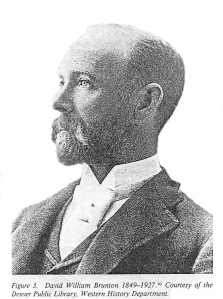
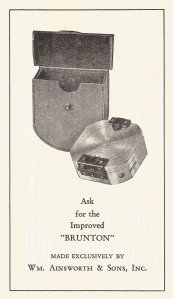

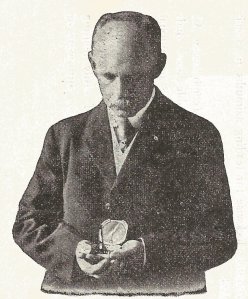
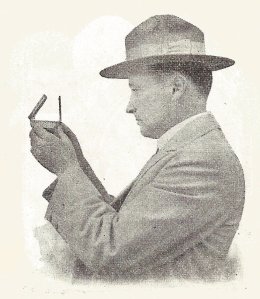
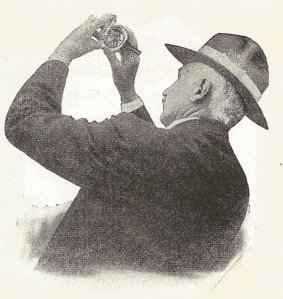

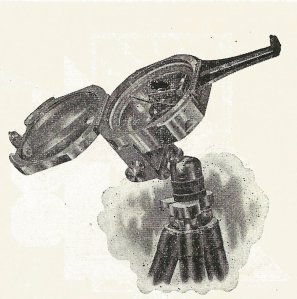
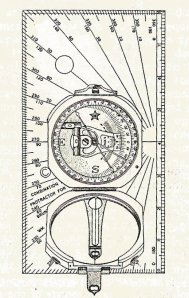
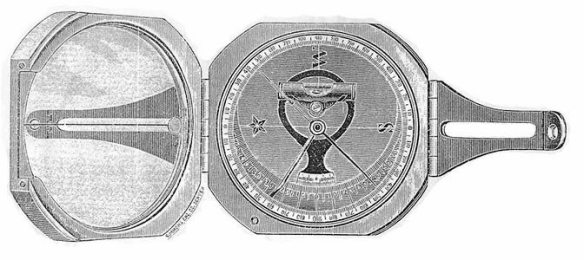

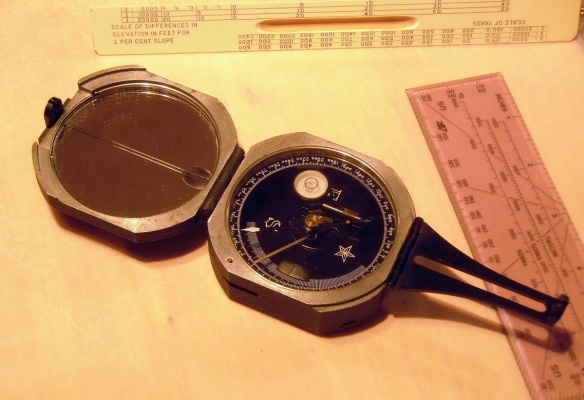
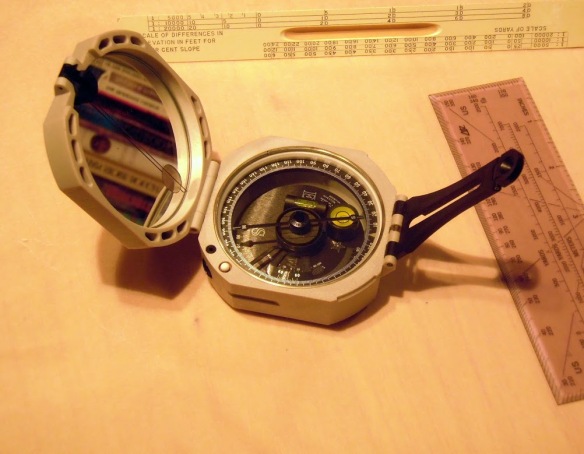
Hi,
In the mid 1990’s I found a Brunton “style”pocket transit compass in the garden, underneath ivy. I suspect it had been there for 20 years or more. I recently started studying geology so have become more interested in my find. It appears to have an aluminium case which is painted black and showing some surface corrosion. The only marking I can find is TZS in a diamond shape in the center of the lid. The clinometer works well but the compass needle sticks suggesting a bend some where. It is marked in 360 degrees. I would be interested in the manufacturer and whether it is worthwhile repairing this instrument.
Anne, if you can provide a picture or two we might be able to help you out. The TZS marking is one I’m not familiar with.
Anne,
Would you be able to provide some pictures of your instrument in particular the top of the closed case, the bottom of the case and the top of the open case? The amount of knowledge on this site is quite extencsive and with pictures such as these, I am sure that someone will be able to give you some insight on your instrument. Bruntons and Ainsworth pocket transits along with their military variants are quite robust with the exception of the mirror on the inside of the the top cover (we used to use those a shaving mirrors in the Corps). There is a decent chance that it can be brought back to life with a bit of maintenance if it is not too badly damaged.
I have a K&E Pocket Transit I bought in the Marines in 1973. It needs the bellows replaced. Is there anywhere I could find replacement parts for this unit?
Lee, unfortunately K&E is long out of business and as far as I know there is no one that stocks replacement parts or services them. Sorry
I am trying to contact Brunton to find out the status of the repair of my pocket transit. I sent them in for repair over 2 weeks ago and have not receivd any conformation that have been received or being worked on. I would appreciate any info on who to contact regarding my transits. thanks Neal
Neal, sorry but I can’t help you here. We have no official connection with the Brunton company. I recommend you contact the company by phone to find out the status of your repair.
Brian –
Thanks for writing such an in-depth post with images on the Brunton Pocket Transit. I’m the Marketing Manager for Brunton and over the years the company has lost a fair amount of it’s history and I am on a mission to gather some of it back. Could I share the above as a potential blog post (crediting you)? I would also love to have access to the images if you are willing to share them. Let me know. I shared my email and will also try to connect via your contact information!
Rebecca,
I’d love to have Brunton share this information out. Please contact me at brian.haren@gmail.com to discuss the details.
Hello Rebecca. I have a early Brunton compass that needs a glass cover and retainer ring to secure the cover glass. Is this something you can help me obtain for my pocket compass. Thanks for your attention in this matter. Neal Dawson
Are you familiar with the 1980’s era Denver Geodetic (brand) pocket transit, that looked like a well-made knock-off of the Brunton design? I almost bought one in 87 for $99 on close-out at Brunson surveying instruments when renting a total station and EDM. I’d sure appreciate any input. Thank you.
I inherited my uncle’s Military (M2?) olive drab Brunton compass which he used in WW II in the Pacific theatre. I still have the battered canvas belt holder he used, but I bought a fine new leather brunton case for it a few years ago. One of the sights fell off ( I have the piece) and I am wondering where I can send it to be repaired and serviced. (I now live in the UK– can you recommend someone to fix it here? postage & insurance across the Atlantic back to the US would be very expensive.) Thanks.
Hi Brian, thanks to your site, I’ve run down enough background to work on my K&E D.G.-30 pocket transit. It is the Brunton copy with Pat. Feb 2, 1926 marked but I think it is a 1950’s production. Your resource patent page gave me enough information to figure out the declination adjusting screw design and arrangement. I had to take it apart to adjust declination after Brunton Co. advised me they do not repair non Brunton equipment. I’ll send you pictures of the transit and circle adjusting screw to you gmail address.
Hello,
My name is Andrew Brown. I am a sixth grader and my history teacher gave this M2 pocket transit compass to me to research for a class presentation. I found your website when I searched on the internet. It has good information. Would you be able to tell me when it was made and possibly what it was used for by the serial number 56810? I look forward to reading your reply.
Thank you,
Andrew
Andrew,
Thanks for your email and inquiry. The M2 pocket transits were a special type of transit manufactured for the US military starting in WWII, specifically for use by artillery units. You probably have noticed that the compass ring is not marked out in degrees, but in what we call ‘mils’. A mil is 1/64000 of a circle. Since field artillerists need to be especially precise when aiming their artillery guns it was felt that the standard compass with a 360 degree circle was not precise enough. So the artillery adopted the ‘mil’ as a standard division of a circle to allow more accurate and precise aiming.
Unfortunately there is no database of serial numbers for M2 compasses. They were made by several different manufacturers from WWII onwards. Is there a data plate on the transit cover that shows the manufacturer’s name?
Brian
Brian,
The mil division of the M2 Brunton is 1/6400s of a full circle, not 1/64000s of a full circle as indicated above.
I have an original Ainsworth sold to me by a retired paleontology professor in 1984. It belonged to her late husband, a structural geologist and remains a treasured possession of mine. The serial number indicates it was made in 1936. I used it for my Master’s thesis mapping and many subsequent projects. I’ve also had three of the acetate alidade protractor base plates over the years: one was stolen with my field kit (which included one of the last Bruntons actually made by Ainsworth) while in New Mexico, one was badly warped in a hot glove box and one is in my desk. It was supposed to come with an indexing screw that replaced and protruded from the base plate of the Brunton. They worked well with traverse boards for reconnaissance mapping in areas without topography maps or with aerial photo mosaics to located points and map structural data. A good book demonstrating the excellence of the Brunton Pocket Transit is “Measuring Stratigraphic Sections” by the late Frank E. Kottlowski, former New Mexico State Geologist.
Bob, thanks for the comment. Those alidades are still as rare as hen’s teeth. I have not seen one on eBay in years. I’m going to try to find a copy of ‘Measuring Stratigraphic Sections’ – thanks for the recommendation!
Brian,
I have been collecting Brunton/Ainsworth Transits since Geology Grad School. I ran across this particular transit, do you know anything about this.
BRUNTON & PEARSE’S MINE TRANSIT – NEGRETTI & ZAMBRA LONDON Serial No.356
In addition I was able to purchase a couple of Mining Transits, very nice and somewhat rare.
Brian,
Another recommendation is Compton’s 1962 Manual of Field Geology. He goes into many practical applications of the Brunton Pocket Transit plus a very nice chapter on using a Plane Table and Alidade for topographic mapping and geologic mapping. When I was taking field mapping methods as an undergraduate in the early 70’s, this was my go-to book. However, the professor teaching us in the field preferred using Frederic Lahee’s Field Geology which assumes prior courses in Plane Surveying. Curiously, Lahee lionized the Brunton Pocket Transit in early prints of his book only to switch to the Gurley Compass around the time of David Brunton’s death. The Gurley is much better suited to light surveying and plane-table mapping than the Brunton even with the Alidade Protractor base plate. But it wasn’t really good for taking structural measurements but it was capable of more precise compass bearings. It (the Gurley) was, however, used extensively in early oil and gas exploration mapping along with the typical topography mapping tools and the Brunton Pocket Transit.
Another book is Julian Low’s “Geologic Field Methods”. This is another interesting, hands-on book.
Hello Andrew,
I am aware of at least three different manufacturers of the M2 military compass during WW2. They were Ainsworth, Kuefel & Esser and Kalart. There may be others, but those are the ones that I am familiar with as actually having manufactured the M2 under US Government contract. They will typically have the data plate affixed to the cover by rivets and have the initials of one of the government ordnance inspectors. My M2 was made by Kalart and has the initials of GHD. Sometime after WW2 the data plates were changed to stickers were eventually fell off and the sights were changed slightly to single hole vice “figure eight” holes.
Brian,
Being a student of the old “skrool”, I love this website! Still have my Boy Scout Silva from my time with Troop 466. Don’t do much hiking anymore, as the meniscus troubles in both knees has limited my exploring. My only Brunton is serial numbered at #45700. I have owned this for the better part of 25 yrs. I am presuming it to be of Vietnam war era production.
HOW CAN I SEND YOU a photo of my pocket transit in order to identify it.
Allen, sorry for the delayed response. You can send any pictures to my gmail account at brian.haren@gmail.com and I’ll try to get right back to you.
Hello. I have an Ainsworth Pocket Transit (S/N 89940) that needs repair. It looks like the needle assembly lost a screw that holds it to the base. Do you have a blow-up diagram that could help me fix it or know where I might send it for repair? Any thoughts would be appreciated! Thanks!
Gary, the only company I know of that is doing pocket transit repair & calibration is Brunton in Riverton, Wy. They actually repaired a pocket transit for me several years back. I recommend you contact them directly. You may be able to figure out what’s wrong with your compass by reviewing the Army’s repair manual for the M2 compass. It’s a long shot, but it may provide you enough information to get your pocket transit working. You can view the manual at this link:
https://drive.google.com/file/d/0Bz0ZKN4l6fZfZDA4ZWQ0OTEtOWJlNi00NDVlLTkxMzMtZjI1ZmVjY2RkYTdk/view?usp=sharing
Thanks! I tried Brunton and they sent it back to me. I’ll call them again next week but may try a watch repair place.
No I am still looking for someone to help me repair my older compas. Pre 1980
I’m amazed with this device,sure it gonna give me great changes.
I need a alidade protractor to buy. If anybody know , please , contact me on apopenha@gmail.com.
Aguinaldo, if you are talking about the clear plastic alidades made by Ainsworth and Brunton for use with the pocket transit, good luck in your search. They are extremely rare. I’ve only seen one come up for sale on eBay in the past five years. I’d love to have one or two myself.
I have an Ainsworth Geodetic transit/compass s/n 01182. Can anyone provide date of manufacture info. It would be appreciated muchly. Thanks to any and all, Ron Farmer
I have been collecting Brunton pocket transits for over 10 years and have information on my collection that could be available if you may be interested. My father was a mining engineer and used a Brunton transit for many years. My brother now owns that transit. But I became interested in the Brunton/William Ainsworth history and just kept acquiring these instruments. Most were acquired off Ebay over this time frame. Historically, I used Mr. Hudson’s information on Brunton transits extensively until it was no longer available. I recently came upon your sight. Thanks for reestablishing the sight, particularly the serial number data. My collection totals some 62 transits in various configurations and written materials and various cases and tripods Almost all are Bruntons and range from serial numbers in the 100s to a few production models after the move from Denver to Riverton, Wyoming. Anyway, let me know if this data might be of interest and I will send the list to you. Thanks,
Michael, I’d love to incorporate your pocket transit information into the database, and if you have any unusual models, or models that are new to the database I’d also love to have pictures of them to add to the database.
I have what appears to be a Brunton instrument made by Keuffel & Esser Co. My dad landed at D-Day and was a Field Artillery forward observer. He carried the pocket transit with him and used it to call fire missions. It needs cleaning. Can you recommend someone tondo this kind of work?
Thanks! Rob Hampton
Hamptonrc@gmail.com
Hi Michael
I too have one of the early Brunton/William Ainsworth pocket transit that is in need of repair. The glass is broken on the top when you open the transit. Mine also has the tripod with the leather carring case. I would like to send you some photos in hope that you can help me repair this historical piece of surveying equipment.
Thanks
Neal
check the brunton.com site, they have repair kits.
https://www.brunton.com/collections/professional-geology/products/transit-repair-kits?variant=36323437641882
Hello Michael
Do you have any parts for the early William Ainsworth version of this compus. The mirror is broken and the retainer ring that holds the cover on the pompus is missing. Any help would be greatly appreciated.
Thanks Neal
I have a Brunton Pocket Transit, Serial No. 6469 with the tripod and carring case that was my great grandfathers that I am trying to get repaired. The mirror in the lid and the retainer ring that holds the clear glass in place over the compass. Any help in obtaining these parts would be greatly appreciated. I can replace them myself if I can get them.
Neal, the best advice I can give is to contact Brunton directly to see if they can handle the repair. As long as the retaining ring and the mirror are the same diameter as those currently used in production they may be able to handle the repair. Good luck!
Brian
Neal, were you ever successful in getting your Pocket Transit repaired? I inherited one not quite as old (serial 36,850) and have been trying hard to find a place that can repair it. I was told by Brunton they don’t repair anything made after 1980. Tried several other places as well. Thanks in advance!
I am still looking for someone to repair my compass. Have you had any luck in getting yours repaired?
Hi,
I will upload photos later. But for now, it has no markings of any sort, no name, no serial number no broad arrow. I have also just noticed that it does not have the slots on the base for mounting onto a tripod.
Phil, the lack of slots could indicate several things – either a copy of an early Brunton (by Ainsworth) or perhaps a copy of a K&E (the early K&E models used a different mounting setup). By chance are there any screw holes in the bottom of the case?
Hi,
I have just come across what appears to be an early Brunton Transit, but it’s a bit different from what I expected. It has no front sight, second spirit level (pre 1913?) or makers name and the North point is just the letter ‘N’ not the usual star. It is calibrated in degrees 0 – 360 and the clinometer is in ratios 1/4 etc.The body is aluminium, not brass and the needle is really slim, not crude as found in the Indian fakes. It was supposedly used by a British soldier at the end of WW2, as anybody got any suggestions on who might have made it.
Phil, can you provide photos? I believe some British instrument makers produced Brunton copies (Hilger and Watts is the one company I know of) but I’ve never seen pictures of any British produced models. You can email the photos to oldtopographer@gmail.com By chance is it stamped anywhere on the case with the British Ordnance ‘broad arrow’ marking? Does it have a serial number anywhere? If we can determine the maker and country of origin I’d love to add it to the Pocket Transit database. Thanks!
I would think that getting “down in the weeds” (often literally) with the Brunton would be more appropriate and more accurate in some situations, although slower, than modern computerized GIS methods. “Back to Basics” is often the best way to get the job done and the Brunton pocket transit fills the bill.